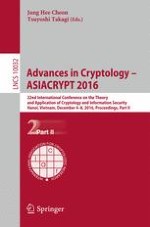2016 | OriginalPaper | Chapter
Multi-input Functional Encryption with Unbounded-Message Security
Authors : Vipul Goyal, Aayush Jain, Adam O’Neill
Published in: Advances in Cryptology – ASIACRYPT 2016
Publisher: Springer Berlin Heidelberg
Activate our intelligent search to find suitable subject content or patents.
Select sections of text to find matching patents with Artificial Intelligence. powered by
Select sections of text to find additional relevant content using AI-assisted search. powered by
